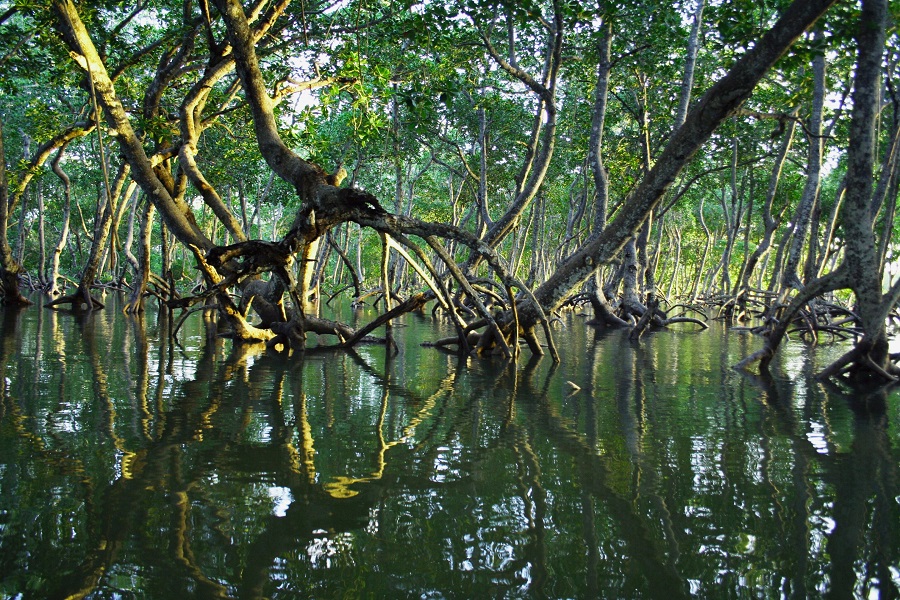11 Dec 2024

Tired Earth
By The Editorial Board

Earth's oceans and coastal ecosystems are a major sink for carbon storage, known as blue carbon. Sequestration of carbon is vitally important in the fight against climate change as it 'locks away' this molecule, alleviating pressure on greenhouse gas-induced warming. Seagrasses, salt marshes and mangroves are important carbon sinks in our coastal ecosystems, with a fast rate of sequestration over long timescales. However, anthropogenic activities are threatening their survival, posing a risk of damaging these areas, resulting in the release of carbon back into the atmosphere to contribute to climate warming once more.
Microplastic pollution (particles <5 mm diameter) is one such issue affecting mangroves in particular. These tiny fragments can be of primary origin, such as microbeads used in personal care products like face washes and even toothpaste, or secondary from the decomposition of larger plastic pieces, such as water bottles and plastic bags.
Previous research has estimated that up to 12.7 million tons of plastic pollution entered the oceans in 2010, which is expected to have doubled by 2025 without appropriate intervention, and is carried globally via wind and currents.
Associate Professor Peng Zhang, of Guangdong Ocean University, China, and colleagues investigated the mangroves of the semi-enclosed Zhanjiang Bay, China, to determine the impact of microplastic accumulation on their ability to store carbon in new research published in Frontiers in Marine Science.
As highly productive ecosystems with high sedimentation rates and well-developed root systems, mangroves have been found to be a crucial component of blue carbon sequestration—covering just 0.5% of global coastal areas but being able to store 5% of total global carbon.
The research team investigated the abundance, composition and diversity of microplastics between sediments both within and adjacent to mangroves at five locations within the bay. The bay is fed by the Nanliu, Lvtang and Suixi rivers, which are in close proximity to Zhanjiang city and industrial plants along its course, being known for heavy urban sewage and agricultural runoff pollution. Two additional sampling locations included in the study are the Sino-Australian Garden tourist attraction and Potou Primary School.

The highest number of microplastics were recovered from non-mangrove samples taken along the Nanliu River, while those from mangroves predominated in Sino-Australian Garden samples. The latter scenario is postulated to be due to insufficient containment and removal of plastic waste from tourists, therefore being exposed to weathering, causing the decomposition of larger plastic items, particularly from food and beverage waste.
Identifying samples up to 5,000 µm, the most common microplastic size across all samples was 100–330 µm, with over half being <500 µm. While 12 colors were identified in the samples, five were most prevalent in the non-mangrove samples, these being green (~22%), black (~17%), transparent (~17%), blue (~15%) and multicolor (~15%).
Comparatively, the mangrove samples were instead dominated by multicolor microplastics (~28%), followed by transparent (~16%) and blue (~10%). Many of the colored fragments and fibers are thought to derive from domestic activities, such as textile washing, while transparent fragments are likely from plastic bags.
In both sediment types, microplastic fragments were most abundant, being ~49% and ~70% for non-mangrove and mangrove samples respectively, followed by fibers at ~37% and ~12% respectively. The prevalence of fragments is attributed to be from items used in the fishing industry, such as nets.
Dr. Zhang and colleagues found that there was no significant change in particulate organic carbon in line with microplastic particle accumulation in this particular bay, but stress that this is likely due to their sampling intensity and that they therefore plan to conduct further research to support this pattern that has been identified in other mangroves globally. They did however find a trend of higher organic carbon in mangrove samples compared to non-mangrove sediments.
Despite this, the research is important as microplastic accumulation disrupts oxygen uptake and nutrient supply to mangroves, threatening their growth and expansion, and therefore their ability to convert atmospheric carbon to organic carbon via photosynthesis, exacerbating climate change further. They also pose a risk to organisms inhabiting these environments, ingesting the microplastics and causing health issues or death, as well as accumulating further through the food chain.
As such, continued strategies to mitigate against new and existing plastic pollution are paramount to combating the effects of anthropogenic activities and securing the longevity of natural carbon sink reservoirs.
Source : phys.org
Comment